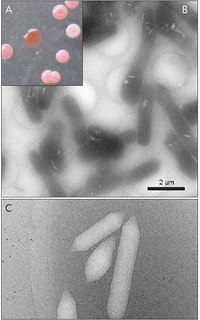
Photo from wikipedia
ABSTRACT Long interspersed element-1 (LINE-1 or L1) retrotransposons replicate through a copy-and-paste mechanism using an RNA intermediate. However, little is known about the physical transmission of retrotransposon RNA between cells.… Click to show full abstract
ABSTRACT Long interspersed element-1 (LINE-1 or L1) retrotransposons replicate through a copy-and-paste mechanism using an RNA intermediate. However, little is known about the physical transmission of retrotransposon RNA between cells. To examine the horizontal transfer of an active human L1 retrotransposon mediated by extracellular vesicles (EVs), human cancer cells were transfected with an expression construct containing a retrotransposition-competent human L1 tagged with a reporter gene. Using this model, active retrotransposition events were detected by screening for the expression of the reporter gene inserted into the host genome by retrotransposition. EVs including exosomes and microvesicles were isolated from cells by differential centrifugation. The enrichment of L1-derived reporter RNA transcripts were detected in EVs isolated from cells expressing active L1 retrotransposition. The delivery of reporter RNA was confirmed in recipient cells, and reporter genes were detected in the genome of recipient cells. Additionally, employing qRT-PCR, we found that host-encoded factors are activated in response to increased exposure to L1-derived RNA transcripts in recipient cells. Our results suggest that the horizontal transfer of retrotransposons can occur through the incorporation of RNA intermediates delivered via EVs and may have important implications for the intercellular regulation of gene expression and gene function.
Journal Title: Journal of Extracellular Vesicles
Year Published: 2019
Link to full text (if available)
Share on Social Media: Sign Up to like & get
recommendations!